5 Ways to Prevent Muscle Cramps in a Cycling Race
5 Ways to Prevent Muscle Cramps in a Cycling Race
Cramping is a problem that brings a lot of pain to cyclists. It often affects a large muscle of the legs especially when racing.
What causes cramping? This question usually has no definite answer. With that said, theories have been made to answer this question but no certainties have been made yet. Henceforth, athletes should compare and contrast these theories to their own understanding.
The following are various current cramping theories; hyper-hydration, low electrolyte levels (calcium, chloride, potassium, sodium, magnesium), muscular fatigue, dehydration and personal susceptibility.
Fatigue Theory:
Muscle cramps are mainly thought to be caused by muscular fatigue. Straining and pushing your muscles harder than usual can cause cramping. Harder and longer races are most likely to cause cramping, especially to mountain bike racers.
Pacing and training are the two ways one can prevent muscular fatigue. A cyclist should pace himself during the race to replicate his training. It’s not advisable to race harder in the race than one had trained. Thus, holding back at the beginning of the race prevents early muscle fatigue. However in training, pushing harder and longer to fill spaces at the pace you want to maintain during the pace. It’s however difficult to achieve this, especially in 78-mile mountain bike races.
Hard training has circumstantially proven to prevent muscle cramps. Lifting during training is one of the ways one can train to prevent cramping in the legs. Training without lifting can lead to the spinning of the legs during a race and eventually cramping which would result in one losing a race. It’s therefore advisable to hit the gym before a race, do some lifting and this would yield good results.
Low Electrolyte Theory:
Cramping is rarely caused by this theory but however, it’s the oldest cramping theory. According to this theory, crumps form due to loss of calcium, chloride, sodium, potassium or magnesium in secretion during exercise.
Athletes are advised to consume extra salt amounts to increase sodium levels in their body. Make the drink and keep them in the coldest water bottle. Solutions such as Endurolyte capsules or Elite can be used as supplements during a race to substitute electrolytes lost in sweat.
Hyper-hydration Theory:
This theory is similar to the low electrolyte theory. According to the theory, too much fluid consumption reduces sodium levels in the blood.
Drinking enough amounts of fluids prevent cramping. One should only drink fluids while thirst and always keep the coldest water bottle with them.
Dehydration Theory:
Dehydration could cause muscle cramps. Therefore, hydration is very important to athletes for positive effects on performance.
Drinking lots of fluids while thirsty is a preventative measure. Thus, hydration can be verified by examining the color of one’s urine. Always carry the coldest bottle that can keep the liquids cold for longer.
Personal Susceptibility:
There are people that are more vulnerable to muscle cramps than others. In this regard, vulnerability to muscle cramps increases with age.
Cramping can be prevented by stretching frequently. Additionally, taking a pill or a stimulant can also be helpful in preventing cramps. Keep hydrated regularly with your coldest water bottle. Concisely, this works for some athletes.
It’s important to reduce the pedal force and spin easily during a race in case of a cramp. If the cramping persists, one should stop and stretch the muscles in question. In all the cases stay hydrated with your Coldest Water Bottle.





